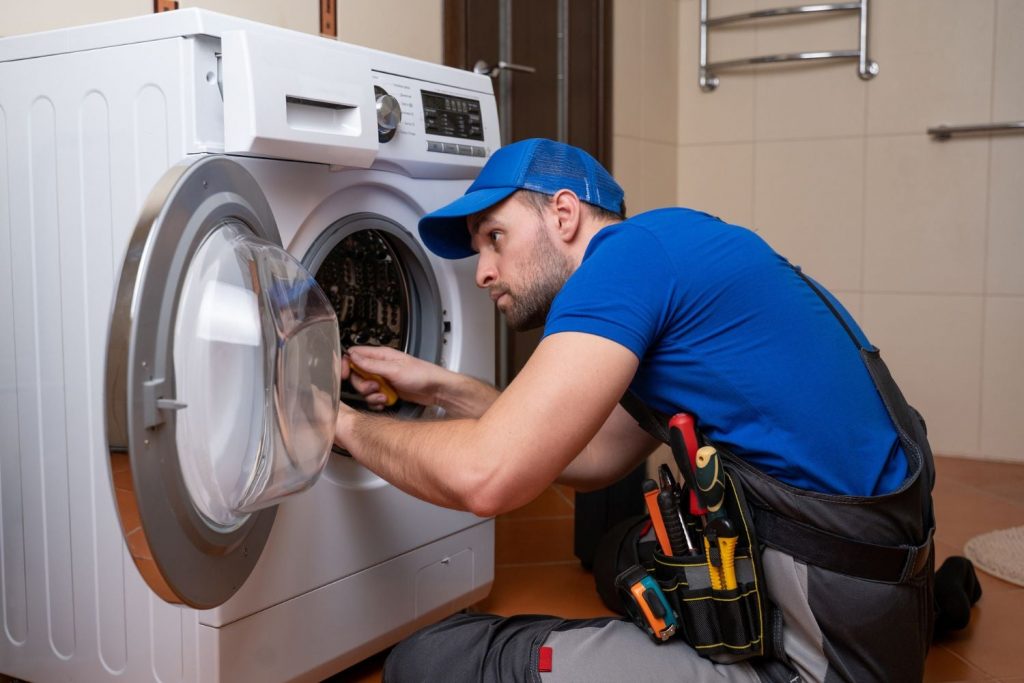Modern washing machines have a built-in water heating function. The water-heating function is incredibly useful when your garments have stubborn stains that are hard to remove.
While deep stains are hard to clean with cold water, hot water can easily remove them. But how to check if washing machine is heating water?
However, like with any other appliance, certain problems can sometimes lead to malfunctioning. For instance, issues with your washer’s heating function can lead to the dysfunction of the entire washing machine.
So, let’s discover how to check if your washing machine is heating water!

How to Check If Washing Machine Is Heating Water
To check if a washing machine is heating water, follow these steps:
- Consult the user manual: The first step is to review the washing machine’s user manual. It will provide information about whether the appliance has a built-in water heating feature. Not all washing machines have this functionality.
- Select a hot water cycle: Set the washing machine to a hot water wash cycle. Most machines have different temperature settings like “hot,” “warm,” and “cold.” Choose the “hot” option for the test.
- Wait for the cycle: Allow the washing machine to go through its wash cycle. This typically takes 30-60 minutes, depending on the machine and the selected cycle.
- Touch the water: Carefully open the washing machine’s door or lid during the cycle, being cautious of hot steam. Reach in and touch the water inside the drum. If the machine is heating water, the water should feel noticeably warmer than the incoming water supply temperature.
- Use a thermometer (optional): For a more precise check, use a thermometer to measure the water temperature. Insert the thermometer probe into the water and check if it matches the temperature setting on the machine.
If the water feels significantly warmer or matches the selected temperature setting, then the washing machine is heating the water correctly.
If the water remains cold, it might indicate an issue with the heating element or the washing machine’s heating mechanism, in which case it may require professional inspection or repair.
Safety Measures When Dealing with Electrical Components
Dealing with electrical components can pose potential hazards, so it’s essential to prioritize safety during the inspection process. Follow these safety measures:
- Power Off: Before starting the inspection, ensure the washing machine is completely powered off and unplugged from the electrical outlet. This step minimizes the risk of electric shock or accidental activation during the examination.
- Wait for Cooling: If the washing machine has recently been used, allow sufficient time for the components to cool down. Some parts, such as the heating element, can retain heat even after the machine is turned off, and touching them prematurely can result in burns.
- Use Personal Protective Equipment (PPE): Wear appropriate safety gear, such as insulated gloves and safety goggles, to protect yourself from potential electrical shocks or accidental splashes during the inspection.
- Work in a Well-Lit Area: Ensure the workspace is well-lit, allowing you to clearly see the components and any potential hazards. Avoid working in damp or wet environments to minimize electrical risks.
Read more: Do I Need A Check Valve For Washing Machine?
Reasons for the Heating Feature Not Working
A defective heating element
On most machines, you can access the heating element from the back. However, the heating element may be accessible from the front of some washing machines.
Typically you will find it under the drum. Before you check if it is defective, you should first sever the connections from the terminals.
Next, get a multimeter, and set it to the low resistance setting. Continue by attaching the meter’s probes to the heating element’s terminals.
If the reading on the multimeter is around 27 to 28 ohms, it is within the acceptable range for a working element.
However, if it is not within this range, the heating element is likely defective, and you will need to contact a professional.
The temperature sensor is not working
Next to the heating element, you will find the temperature sensor. You can remove the sensor by pulling it out and unplugging it. You will need to use the multimeter again, but this time with a greater resistance value.
Continue to attach the probes to the sensor’s terminals, and a functioning sensor should register a reading between 20,000 and 50,000 ohms.
Place your hand over your sensor to see if it is functioning; if it is, the reading should decrease. If not, your sensor is the issue.
Faulty wiring
After you have checked out the heating element and the sensor and have determined that they are not the issue, the next step is to inspect the wiring around the heating element to ensure it is not burnt, damaged, or loose in any way.
If the wiring is faulty, you will need professional help.
A defective control board
Once you are confident that the wiring is sound, but you still need help to identify the problem’s cause, the control board may be to blame.
The safest way to resolve the issue is to contact a maintenance service.
Also read: What Does The Steam Function On A Washing Machine
Conclusion
The water-heating function in modern washing machines proves to be highly advantageous when dealing with stubborn stains on garments. But how to check if washing machine is heating water?
To check if your washing machine is heating water, refer to the user manual for information on its heating capabilities, select a hot water cycle, and observe if the water becomes noticeably warmer during the wash cycle.
Safety measures should always be followed when dealing with electrical components. If the water remains cold, it may indicate issues with the heating element, temperature sensor, wiring, or control board, requiring professional inspection or repair.
Overall, regular maintenance and proper handling can ensure the efficient functioning of the washing machine’s heating feature.







